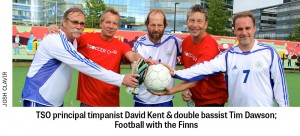 The year was 1951, the month November and the Toronto Symphony Orchestra was about to venture beyond the borders of Canada (indeed, of Ontario) for the first time. Destination? Detroit.
The year was 1951, the month November and the Toronto Symphony Orchestra was about to venture beyond the borders of Canada (indeed, of Ontario) for the first time. Destination? Detroit.
Only this was the period when the junior senator from Wisconsin was looking for suspected communists beneath every bed and the orchestra happened to include players being denied entrance to “the land of the free and the home of the brave” through the pinkish hue of their political complexion.
Torontonians felt a sense of outrage. Our orchestra should go intact or not at all, some voices argued. The conductor, Sir Ernest MacMillan, Canada’s first and only musical knight, felt differently. He wanted the engagement. So he dumped the so-called Symphony Seven and the orchestra wound up making its American debut without them.
Although Sir Ernest may not have behaved honourably, he did understand an important fact of musical life. No matter how good an orchestra may be, it cannot claim to be international without appearing internationally.
Just over a year later the TSO was back in Detroit. By 1959 its foreign reach extended to Buffalo. By 1963 it was playing in Carnegie Hall.
The first time I heard the orchestra live, at the Commonwealth Arts Festival in London in 1965, it was rewarded with a review by Felix Aprahamian in the prestigious Sunday Times praising “orchestral playing of the great international class.”
So where did it go from there? To Japan in 1969, back to Europe in 1974, to Japan and China in 1978 and to Europe again in 1983, with various American stops in between. Not exactly a busy foreign touring schedule but active enough to show the flag.
 This year, from August 13 to 25, the orchestra embarked on another European tour. And this time presenters found the flag barely recognizable; it had been all of 14 years since Toronto’s finest had last appeared on the continent. Hoped-for invitations to the Edinburgh Festival and London Proms, features of previous tours, simply did not appear. The eventual 12-day, five-city, five-nation itinerary began in Vienna (actually the outdoor Grafenegg Festival near the Austrian capital) and continued in Amsterdam, Wiesbaden, Helsinki and Reykjavik.
This year, from August 13 to 25, the orchestra embarked on another European tour. And this time presenters found the flag barely recognizable; it had been all of 14 years since Toronto’s finest had last appeared on the continent. Hoped-for invitations to the Edinburgh Festival and London Proms, features of previous tours, simply did not appear. The eventual 12-day, five-city, five-nation itinerary began in Vienna (actually the outdoor Grafenegg Festival near the Austrian capital) and continued in Amsterdam, Wiesbaden, Helsinki and Reykjavik.
By comparison, the Montreal Symphony Orchestra’s tour earlier in the year visited Zurich, Bern, Geneva, Vienna, Madrid, Oviedo, Cologne, Essen and Munich. Thanks largely to its recorded legacy, most of it under the direction of Charles Dutoit, Montreal’s orchestra has long been the better-known ensemble internationally, which makes it a more saleable enterprise.
On the other hand, had the TSO not undertaken this summer’s tour its music director, Peter Oundjian, feared that it would no longer be saleable in Europe at all. The reason is that a proposed larger European tour of two years ago wound up being cancelled for fear of red ink in the books. A second cancellaton – which appeared to be looming – might well have permanently compromised the orchestra’s credibility.
So Oundjian decided to act, offering to surrender his entire conducting fee for this year’s adventure if his board would rise to the challenge. Veteran board member Bob Corcoran promptly put up $100,000. Renette and David Berman agreed to be lead patrons. And within relatively short order enough money had been pledged, supplemented by fees, government grants and corporate support, to guarantee that the ink in the books would be black.
Touring a full-scale symphony orchestra is not, under normal circumstances, a profit-making undertaking. The Toronto Symphony Orchestra’s 12-day plane and train ride cost a substantial $2.15 million.
So is the effort worthwhile? Peter Oundjian contends that it is, pointing out that as costly as touring may be, such smaller American cities as Boston and Cleveland regularly raise the sums necessary to preserve their orchestras’ profile.
That profile pays dividends at home, not only in orchestral morale – players thrive on foreign applause and the TSO received plenty of it this summer – but in local support. The Maple Leafs notwithstanding, cities love to back a winning team.
Perhaps less tangible is the value of such tours to cultural diplomacy. In both Helsinki and Reykjavik Canada’s ambassadors turned up at receptions in the orchestra’s honour. “You are the real ambassadors,” declared Stewart Wheeler, ambassador to Iceland. And Andrée Noëlle Cooligan, Canada’s ambassador to Finland, made a direct link between Canada’s reputation for cultural excellence and its ability to sell products abroad.
While our diplomats see obvious advantages to the reputation our cultural ambassadors give Canada as a source of excellence, government support for cultural diplomacy has greatly diminished in recent years. The TSO recognizes that if it is to show the flag in the future, its supporters will have to do much of the carrying.
A number of board members and other supporters accompanied the orchestra on its summer journey, witnessing at first hand evidence to support Oundjian’s claim that the TSO really is accepted as a world-class orchestra and can perform valuable service on Toronto’s, and Canada’s, behalf.
No less a personality than Prince Metternich entertained these patrons in his historic castle prior to the Grafenegg Festival concert. No less a presenter than Frankfurt’s Alte Oper issued the orchestra an open invitation following its Wiesbaden concert.
The German clarinetist-composer Jörg Widmann was soloist in Grafenegg and Wiesbaden, the Canadian violinist James Ehnes in the other tour cities. Although Canadian music was included on the programs, represented by Claude Vivier’s Orion, the late Montrealer’s opus appeared only in Helsinki and Reykjavik, a gesture at best.
But as Oundjian points out, little more than a gesture will have been accomplished by the tour as a whole if another 14 years passes before his players once again cross the Atlantic. As cellist David Hetherington adds, “calling yourself world-class doesn’t mean much if you don’t tour the world.”
Toronto’s Tafelmusik Baroque Orchestradoes, of course, tour the world and has done so for most of its 36 years. Now widely recognized as one of the pre-eminent period instrument ensembles, it added a feather to its already well-plumed cap in June by following Germany’s celebrated Freiburg Baroque as only the second orchestra invited to be ensemble-in-residence by the International Bach Festival in Leipzig.
Touring has been basic to Tafelmusik’s existence since almost before it had an existence, thanks to oboist co-founder Kenneth Solway’s signing of a contract to bring the barely born orchestra to Carnegie Hall with the famous oboist Heinz Holliger as bait.
Today Tafelmusik typically performs its Toronto concerts five times in order to accommodate its loyal audience, a record unmatched by sister ensembles in the New World and the Old. Even so, it would be unable to provide its players with a full season of work without hitting the road.
With seldom many more and sometimes fewer than 20 players to house and transport, Tafelmusik costs much less to put on tour than a full symphony orchestra or even Ottawa’s National Arts Centre Orchestra, set for its own English tour this fall. In fact, with its lower cost structure, touring actually helps keep Tafelmusik solvent.
Granted, the Leipzig adventure did leave a deficit of about $30,000 – the orchestra could not apply for a government tour grant since it was going to only one city – but the loss represents a small sum relative to the prestige gained through the undertaking. “Of course we knew about Tafelmusik through its reputation and recordings,” acknowledged festival director Dettloff Schwerdtfager (the orchestra has recorded more than 50 CDs for Sony Classical alone). “And they exceeded our expectations.”
Tafelmusik joined Bach’s own choir for the gala opening concert in St.Thomas Church, performing magnificats by both J.S. Bach and his son Carl Philipp Emanuel. At Bach’s other principal church, St. Nicholas, the orchestra performed a program of music by the two Bachs, Telemann and Handel. And again at St. Nicholas, Paul Goodwin, director of California’s Carmel Bach Festival, led the players in their first performance anywhere of Handel’s monumental (eight soloists) Brockes Passion, replacing the indisposed Christopher Hogwood (who died September 24).
Following the performance the players returned to their hotel to toast retiring music director Jeanne Lamon, the musical architect of their success for more than three decades. Summing up the feelings in the room, principal oboist John Abberger declared “I refuse to say goodbye.”
Tafelmusik must find a new managing director as well, now that Tricia Baldwin has accepted the directorship of Queen’s University’s handsome new Isabel Bader Centre for the Performing Arts. Baldwin has seen government support for touring diminish over the course of her Tafelmusik tenure and yet has managed to sustain her orchestra’s profile as the most travelled in the country.
A believer in the benefits of touring as an agent of cultural diplomacy, she argues, “How are we going to get along (as peoples) if we don’t speak to each other? And is there a better way than through music?”
But she also sees practical benefits to her players: “As Jeanne (Lamon) says, we bring Canada to the world and the world back to Canada. Playing in different halls before different audiences is what has kept everybody stimulated at Tafelmusik.
“So when External Affairs cutbacks took place we decided to use our own resources to cover losses because being on the international stage is part of our mandate.”
Whether it can be part of the mandate of a full symphony orchestra in these economically tight times is the question facing its sister orchestra in Toronto. After this year’s European tour, the optimists at Roy Thomson Hall now appear to be in the ascendancy.
William Littler is a Toronto-based writer focusing on music.



